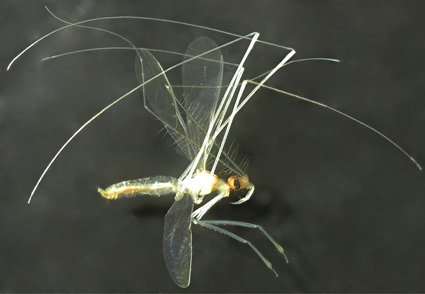Abstract
The Canary Archipelago is home to two species of obligately cavernicolous assassin bugs of the genus Collartida Villiers, 1949 (Hemiptera: Heteroptera: Reduviidae: Emesinae: Collartidini). These species are highly adapted for cave life, being blind and wingless. In the present study, we describe a new species of the genus, C. phantasma sp. nov. from the Federica mine in Gran Canaria. C. phantasma sp. nov. differs from the other two Collartida species found in the Canary Archipelago in that the male is fully winged, the female is wingless, and both sexes have well-developed eyes. We provide information regarding the new species’ habitat, its taxonomic affinities, and its ability to fly.
References
Arechavaleta, M., Rodríguez, S., Zurita, N. & García, A. (2010) Lista de especies silvestres de Canarias. Hongos, plantas y animales terrestres. Gobierno de Canarias, Santa Cruz de Tenerife, 579 pp.
Arnedo, M.A. & Ribera, C. (1999) Radiation of the genus Dysdera (Araneae, Dysderidae) in the Canary Islands: the island of Tenerife. Journal of Arachnology, 27, 604–662.
Emerson, B.C. & Oromí, P. (2005) Diversification of the forest beetle genus Tarphius in the Canary Islands, and the evolutionary origins of island endemics. Evolution, 59 (3), 586–598. https://doi.org/10.1111/j.0014-3820.2005.tb01018.x
Friedrich, F. & Beutel, R.G. (2008) The thorax of Zorotypus (Hexapoda, Zoraptera) and a new nomenclature for the musculature of Neoptera. Arthropod Structure & Development, 37 (1), 29–54. https://doi.org/10.1016/j.asd.2007.04.003
Gobierno de Canarias (2010) Ley 4/2010, de 4 de junio, del Catálogo Canario de Especies Protegidas. Boletín Oficial de Canarias núm. 112. s.n., Comunidad Autónoma de Canarias, 17 pp.
Gobierno de Canarias (2021) Banco de datos de biodiversidad de Canarias. Available from: http://www.biodiversidadcanarias.es (accessed 14 December 2021)
Juan, C., Emerson, B.C., Oromí, P. & Hewitt, G.M. (2000) Colonization and diversification: towards a phylogeographic synthesis for the Canary Islands. Tree, 15 (3), 104–109. https://doi.org/10.1016/S0169-5347(99)01776-0
Linnavuori, R. (1974) Hemiptera of the Sudan, with remarks on some species of the adjacent countries. Families Cryptostemmatidae, Cimicidae, Polyctenidae, Joppeicidae, Reduviidae, Pachynomidae, Nabidaea [sic], Leptopodidae, Saldidae, Henicocephalidae and Berytidae. Annales Entomologici Fennici, 40 (3), 116–138.
Linnavuori, R. (1973) Studies on the hemipterous fauna of Israel and Sinai. Israel Journal of Entomology, 8, 35–54.
Machado, A. & López, H. (2015) A new species of Oromia (Coleoptera: Curculionidae) from the Canary Islands. Zootaxa, 3931 (1), 117–126. https://doi.org/10.11646/zootaxa.3931.1.8
Naranjo, M., Suárez, D.B., Martín, S. & Fernández, O. (2018) Fauna invertebrada de la Mina de La Federica, riqueza subterránea del Barranco de Los Cernícalos (Gran Canaria, Islas Canarias). Gota a Gota, 15, 25–33.
Oromí, P. (2004) Canary Islands: Biospeleology. In: Gunn, J. (Ed.), Encyclopedia of caves and karst science. Fitzroy Dearborn, New York, New York, pp. 366–371.
Oromí, P. (2008) Biospeleology in Macaronesia. In: Espinasa-Pereña, R. & Pint, J. (Eds.), Proceedings of the X, XI and XII International Symposia on Vulcanospeleology. Association for Mexican Cave Studies, Bulletin 19, and Sociedad Mexicana de Exploraciones Subterráneas, Boletín 7. Association for Mexican Cave Studies, Austin, Texas, pp. 114–118.
Oromí, P., Arechavaleta, M., de la Cruz, S., García, R., Izquierdo, I., López, H., Macías-Hernández, N., Martín, J.L., Martín, S., Martínez, A., Medina, A.L., Naranjo, M., Pérez, A.J. & Zurita, M. (2021) Diversidad faunística del medio subterráneo volcánico, con especial énfasis en las Islas Canarias. Boletín SEDECK, 16 (3), 25–50.
Putshkov, P.V. & Moulet, P. (2010) Hémiptères Reduviidae d’Europe occidentale. (Faune de France 92.) Fédération Française des Sociétés de Sciences Naturelles, Paris, 668 pp.
Prashant, P., Prieto, C.E. & Giribet, G. (2011) A new family of Laniatores (Arachnida: Opiliones) from the Afrotropics. Invertebrate Systematics, 25 (2), 143–154. https://doi.org/10.1071/IS11003
Rédei, D. & Tsai, J. (2010) A survey of the emesine assassin bugs of the tribes Collartidini, Leistarchini, Emesini, and Metapterini of Taiwan (Hemiptera, Heteroptera, Reduviidae). Deutsche Entomologische Zeitschrift, 57 (1), 11–36.
Ribes, J., Oromi, P. & Ribes, E. (1998) Una nueva Collartida Villiers, 1949 subterránea de La Palma, islas Canarias (Heteroptera, Reduviidae, Emesinae). Vieraea, 26 (1997), 99–105.
Roca-Cusachs, M., Kim, J., GarcÍa-Becerra, R. & Jung, S. (2019) Journey to the Center of the Earth: Description of a new troglomorphic litter-bug species inhabiting lava tubes in the Canary Islands (Heteroptera: Dipsocoromorpha: Ceratocombidae). Zootaxa, 4550 (4), 557–564. https://doi.org/10.11646/zootaxa.4550.4.5
Suárez, D., Martín, S. & Naranjo, M. (2018) First report of the invasive alien species Caenoplana coerulea Moseley, 1877 (Platyhelminthes, Tricladida, Geoplanidae) in the subterranean environment of the Canary Islands. Subterranean Biology, 26, 67–74. https://doi.org/10.3897/subtbiol.26.25921
Triantis, K.A., Borges, P.A.V., Hortal, J. & Whittaker, R.J. (2010) The Macaronesian province: patterns of species richness and endemism of arthropods. In: Serrano, A.R.M., Borges, P.A.V., Boieiro, M. & Oromí, P. (Eds.), Terrestrial Arthropods of Macaronesia—Biodiversity, Ecology and Evolution. Security Print, Sociedade de Indústria Gráfica, Lda., Lisbon, pp. 49−71.
Troll, V. & Carracedo, J.C. (2016) The geology of the Canary Islands. Elsevier, Amsterdam, 606 pp. https://doi.org/10.1016/B978-0-12-809663-5.00005-0
Villiers, A. (1961) Localisations et descriptions d’Emésides africains. Revue de Zoologie et de Botanique Africaines, 63 (1–2), 33–65.
Villiers, A. (1968) Hémiptères Reduviidae et Pachynomidae de la région du Tchad. Bulletin de l’Institute Fondamental d’Afrique Noire, 30 (3), 1169–1187.
Villiers, A. (1970) Nouveaux Hémiptères Reduviidae de Madagascar et des Comores. Annales de la Société Entomologique de France, 6, 809–824.


